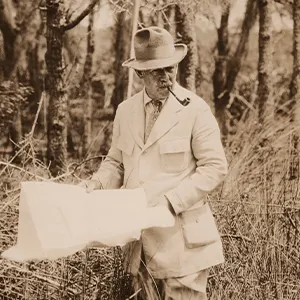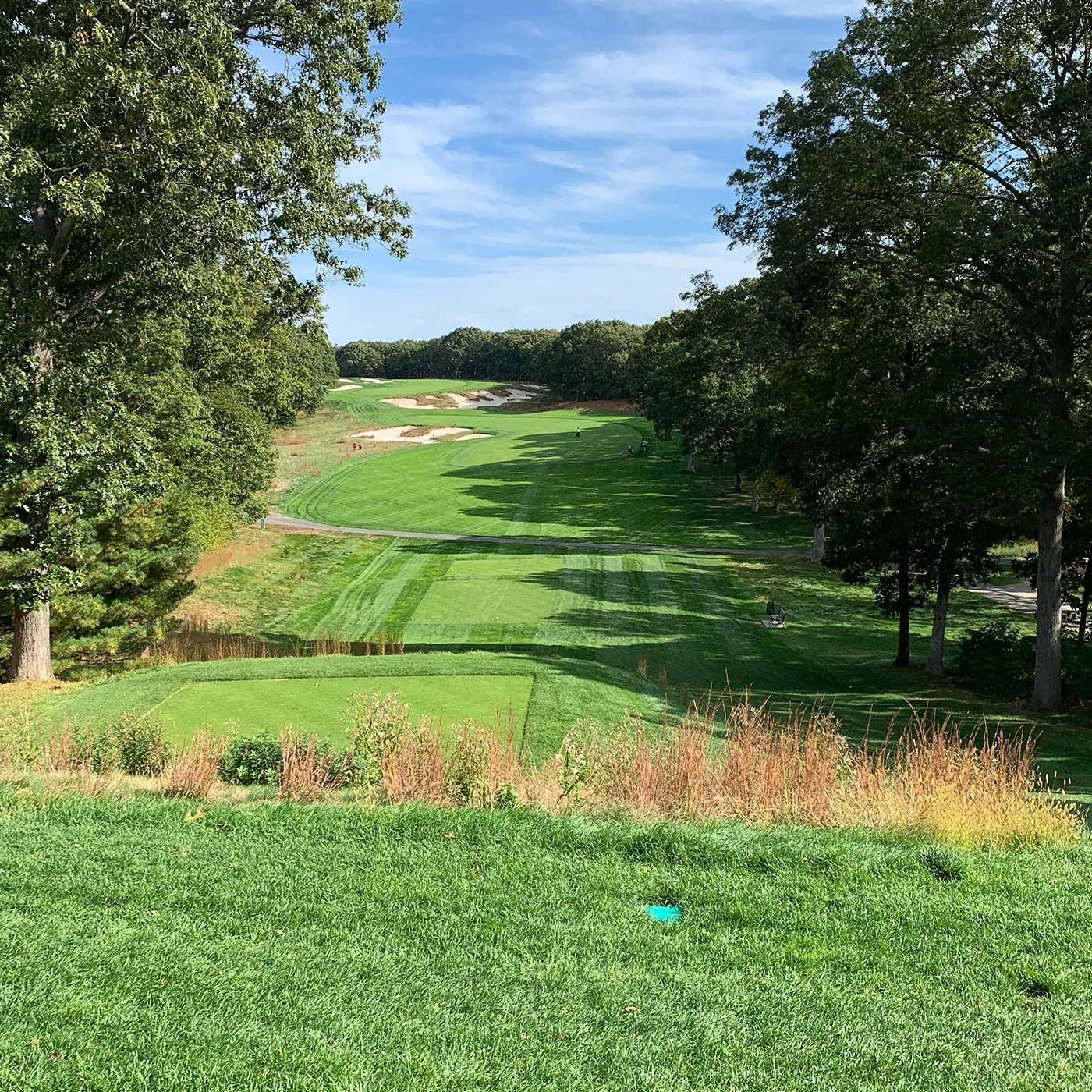A.W. Tillinghast
A Philadelphia aristocrat known for building some of America's toughest championship venues, including Winged Foot West, Bethpage Black, and Baltusrol. His complex, undulating greens test the very best golfers.

May 7, 1876, Philadelphia, Pennsylvania
May 19, 1942
Weekend Chat: Seeing vs. Testing
Winged Foot Golf Club with Golf Architect Gil Hanse | Digging into Design
Albert Warren Tillinghast, often simply called “Tilly,” grew up in Philadelphia in the 1880s, the son of a downtown rubber goods business owner. Albert was a good sportsman in high school, playing rugby and cricket, and running track. He frequented the Philadelphia Cricket Club, where he learned a game relatively new to the area — golf. During a stay in St. Andrews, Scotland, Tillinghast developed a friendship with Old Tom Morris and fell in love with the traditions of the game.
Back at home in Philly, Tillinghast became a good amateur player. He twice made the round of 32 at the U.S. Amateur, captained the 1907 Canada Cup team, and finished 25th at the 1910 U.S. Open at his home club. During the early years of the century, he began a life-long career as a golf writer for a number of regional and national publications.
In 1907, Tillinghast was approached by a friend to design a new course at Shawnee-on-Delaware. The resulting project, his first, opened in 1911. In short order, he advised George Crump on the construction of Pine Valley, dreaming up, according to himself, the seventh and 13th holes. A number of commissions followed at far-flung places such as Brackenridge Park (1915) and San Francisco Golf Club (1915). The threat of World War I did not slow down Tillinghast’s work. In the next few years, he completed projects at Rochester Golf and Country Club (nine holes in 1916, and later a full 18), North Hempstead Country Club (1916), Essex County Country Club (1918), Quaker Ridge Golf Club (1918), and Somerset Hills Country Club (1918).
After the end of World War I, Tillinghast worked at breakneck speed, constantly traveling. Paramount Country Club (1920), Brook Hollow Golf Club (1921), two courses at Baltusrol Golf Club (1922), his home Philadelphia Cricket Club’s Wissahickon (1922), and two courses at Winged Foot Golf Club (1923) resulted. Toward the latter half of the decade, he completed Baltimore Country Club’s Five Farms (1926), Sands Point Golf Club (1927), Sleepy Hollow Country Club (renovation, 1928), and 27 holes at Ridgewood Country Club (1929).
The Great Depression, beginning in 1929, brought many golf course projects to a halt, yet Tillinghast still managed to renovate Brooklawn Country Club (1931) and create, at great expense, Alpine Country Club (1931). Later, Tillinghast took on a New Deal public works project from the New York State Park commission, designing three courses at Bethpage State Park (completed in 1936).
Mostly stepping back from solo course design, Tillinghast spent much of the decade consulting nationwide on hundreds of courses as part of a PGA of America program. From mid-1935 to early 1936, he worked on, according to his own account, over 350 courses, and removed more than 7,000 “unnecessary” bunkers. After the tour, he and his wife moved to Southern California, where partnered up with Billy Bell to renovate Virginia Country Club (1939). A heart attack in May 1940 stopped all work for Tillinghast. He and his wife relocated to Toledo, Ohio, where they lived until his death in 1942.
Somerset Hills Country Club
A.W. Tillinghast’s work at Somerset Hills reflects American golf architecture’s coming-of-age moment in the 1910s—youthful, fresh, and full of excitement
Somerset Hills Country Club
Essex County Country Club
A.W. Tillinghast's 1917 design, redone by Raynor and Banks in 1926, is New Jersey's oldest country club, recently renovated by Gil Hanse.
Essex County Country Club
Winged Foot West Course
Winged Foot West sits on relatively flat terrain with rocky soil, but A.W. Tillinghast’s brilliance shines through in one of the most celebrated sets of greens in the world
Winged Foot West Course


Leave a comment or start a discussion
Engage in our content with thousands of other Fried Egg Golf Members
Engage in our content with thousands of other Fried Egg Golf Members
Get full access to exclusive benefits from Fried Egg Golf
- Member-only content
- Community discussions forums
- Member-only experiences and early access to events









%2520(1)%2520(1).webp)







.jpeg)




.jpeg)
Leave a comment or start a discussion
Lorem ipsum dolor sit amet, consectetur adipiscing elit. Suspendisse varius enim in eros elementum tristique. Duis cursus, mi quis viverra ornare, eros dolor interdum nulla, ut commodo diam libero vitae erat. Aenean faucibus nibh et justo cursus id rutrum lorem imperdiet. Nunc ut sem vitae risus tristique posuere. uis cursus, mi quis viverra ornare, eros dolor interdum nulla, ut commodo diam libero vitae erat. Aenean faucibus nibh et justo cursus id rutrum lorem imperdiet. Nunc ut sem vitae risus tristique posuere.